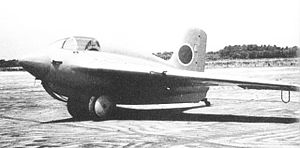avia.wikisort.org - Glider
The Yokosuka MXY8 Akigusa (秋草, "Autumn grass") was a training glider built in parallel with the Mitsubishi J8M rocket-powered interceptor aircraft.
| MXY8 Akigusa | |
|---|---|
 | |
| Role | Training Glider |
| National origin | Japan |
| Manufacturer | Yokosuka Naval Air Technical Arsenal |
| Variants | Yokosuka MXY9 |
Design and development
The J8M was to have simply been a licence-built Messerschmitt Me 163 Komet, but due to difficulties in obtaining technical materials from Germany, it eventually had to be designed almost from scratch.[1] The MXY8 was designed in parallel with the J8M to validate the design, and then to provide pilot training during the development of the actual interceptor.[2] The Army designation for the type was Ku-13.[3]
The MXY8 was built entirely of wood, and fitted with ballast tanks that would be filled with water to simulate the weight and therefore flight characteristics of a fully equipped J8M. Some 50-60 of these gliders were eventually built.
A more advanced trainer, the MXY9, equipped with a primitive jet engine was planned, but was never produced.[4]
Many sources apply the designation MXY8 to the Yokosuka MXY7 Ohka kamikaze weapon.
Specifications

Data from Japanese Aircraft of the Pacific War[5]
General characteristics
- Crew: 1
- Length: 6.05 m (19 ft 10 in)
- Wingspan: 9.5 m (31 ft 2 in)
- Height: 2.7 m (8 ft 10 in)
- Wing area: 17.73 m2 (190.8 sq ft)
Performance
See also
Related development
References
- Notes
- Francillon 1979, p. 404.
- Francillon 1979, p. 405.
- Francillon 1979, pp. 405–406.
- Francillon 1979, p. 406.
- Francillon 1979, p. 407.
- Bibliography
- Francillon, René J. (1979) [1970]. Japanese Aircraft of the Pacific War (2nd ed.). London: Putnam & Company Ltd. ISBN 0-370-30251-6.
На других языках
[de] Yokosuka MXY-8
Die Yokosuka MXY-8 Akigusa (秋草 – japanisch für Herbstgras) war ein japanisches Schulflugzeug aus dem Zweiten Weltkrieg, das speziell für die Schulung von Piloten der Mitsubishi J8M Shusui bzw. Ki-200 (in Lizenz gebaute Kopie des deutschen raketengetriebenen Abfangjägers Messerschmitt Me 163 Komet) gebaut wurde, im Gegensatz zu dieser jedoch nicht motorisiert war, sondern als Segelflugzeug eingesetzt wurde. Die Bezeichnung „MXY-8“ wurde von der kaiserlich-japanischen Marine für dieses Flugzeug vergeben, während die Luftstreitkräfte der kaiserlich-japanischen Armee die Bezeichnung „Ku-13“ verwendeten.- [en] Yokosuka MXY8
[it] Yokosuka MXY8
Lo Yokosuka MXY8 Akigusa (in giapponese 秋草, Erba d'autunno o erba autunnale) era un aliante da addestramento avanzato sviluppato dall'ufficio di progettazione giapponese Kūgishō, il Primo arsenale tecnico aeronavale di Yokosuka,[3] negli anni quaranta.Другой контент может иметь иную лицензию. Перед использованием материалов сайта WikiSort.org внимательно изучите правила лицензирования конкретных элементов наполнения сайта.
WikiSort.org - проект по пересортировке и дополнению контента Википедии